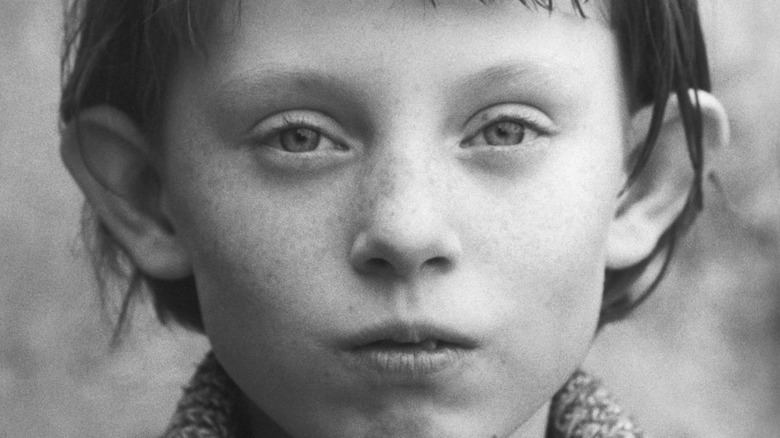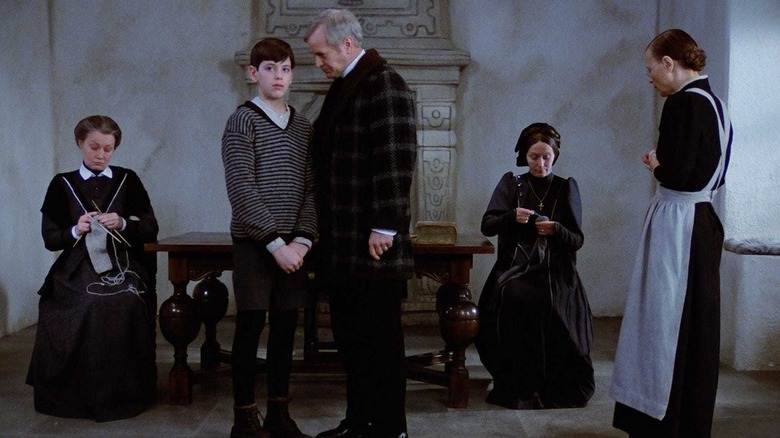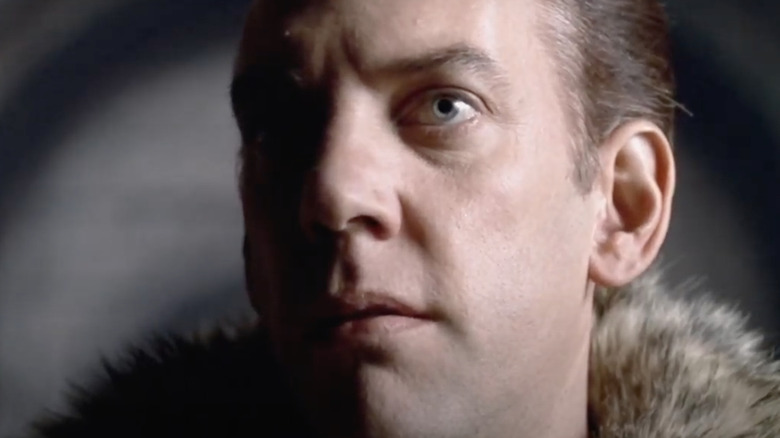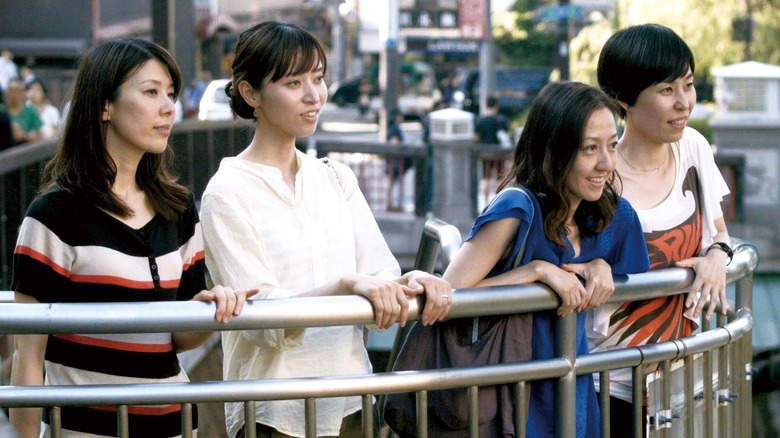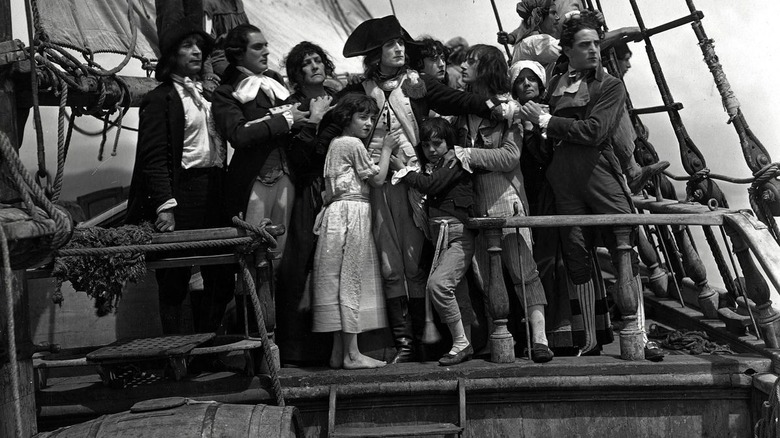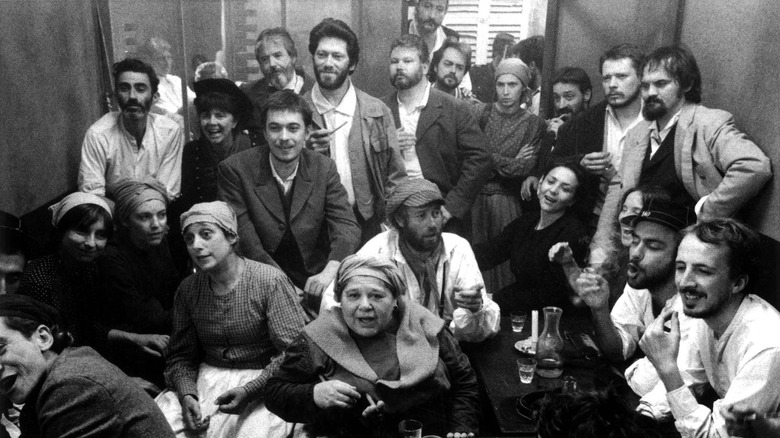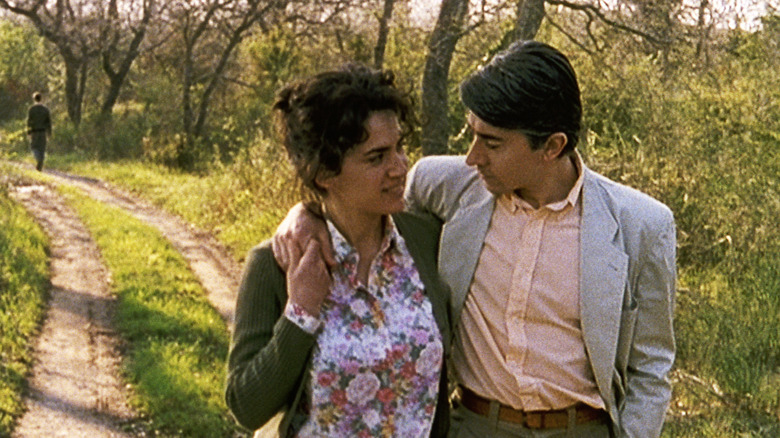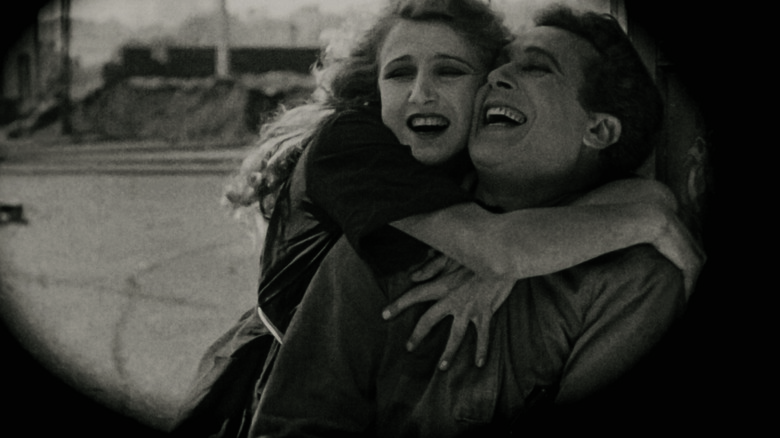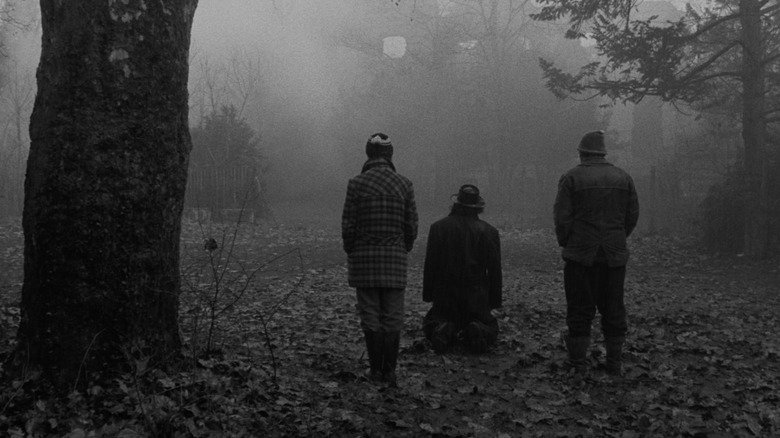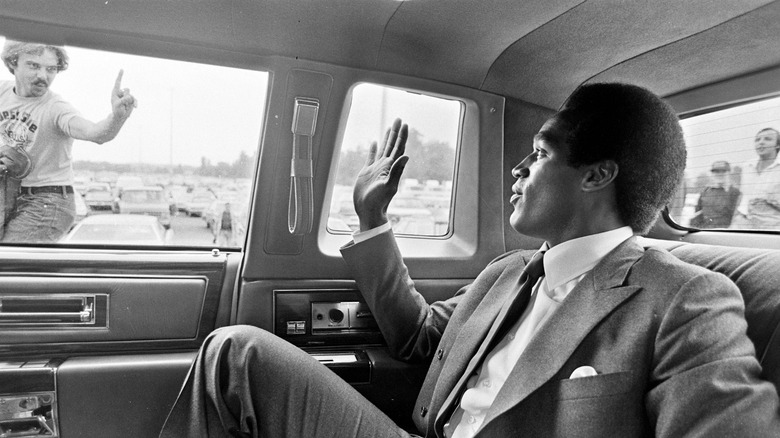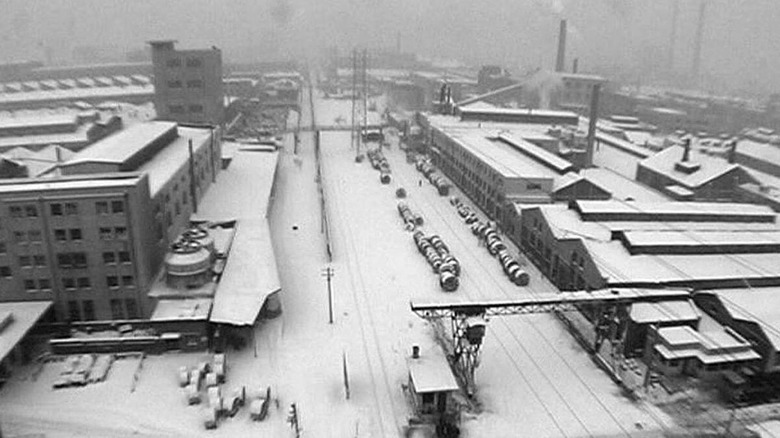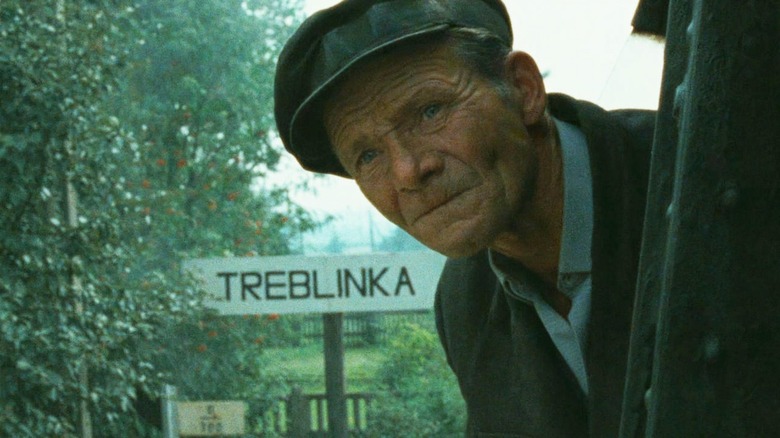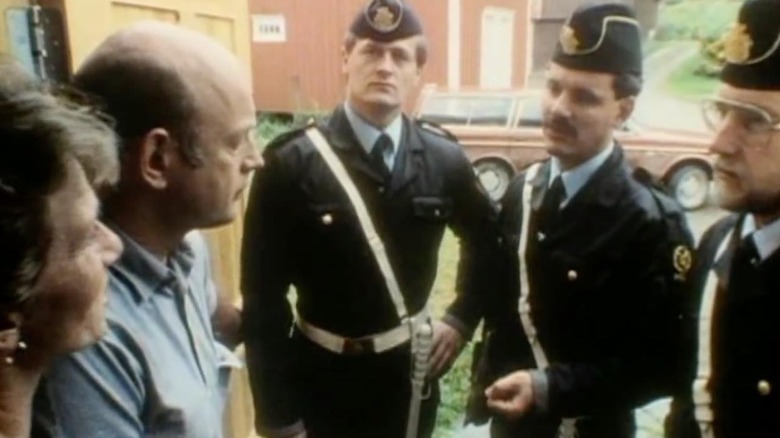The Best Movies Over 5 Hours Long
It's rare to find modern films that run over three hours in length. For the ones that do, like "The Irishman," the extensive runtime is so remarkable that even the actors eventually have to step in and comment on it. General audiences are accustomed to movies that run 180 minutes or less, so any deviation from the norm is bound to receive attention (and sometimes scorn). Plus, in a pop culture landscape that runs more and more on compact entertainment like TikTok videos, sitting down for so long to watch one movie can sound like more of an endurance test rather than an opportunity for entertainment.
If the concept of three-and-a-half-hour long movies blows your mind, just wait until you discover the world of feature films that exceed five hours in length. Though rare, there are titles, many of them widely acclaimed, that require an extraordinary runtime well over 300 minutes to properly tell their respective stories. These films range in subject matter from documentaries chronicling economic matters in China to silent pieces of cinema recounting the early years of Napoleon Bonaparte. There are benefits to embracing such an expansive runtime, as the unique stories and idiosyncratic virtues of these very good, very long movies reveal.
Fanny and Alexander
For the initial theatrical release of "Fanny and Alexander," director Ingmar Bergman had to trim the film down significantly from its original 312-minute runtime to just under three hours. A painful process for the auteur, the original version of "Fanny and Alexander" has managed to endure, prevailing over the shorter incarnation mandated by studio executives. In the process, it has become one of Bergman's most celebrated works, a fitting achievement given that it was one of Bergman's final efforts as a filmmaker.
In 2011, a review from Andre Dellamorte for Collider praised the film for remaining, nearly 30 years after its initial release, as engaging as ever. He also highlighted the way it balances intimate drama with entertainment, like well-executed bathroom gags. The praise for "Fanny and Alexander" even extended to the Academy Awards, where Bergman's lengthy masterwork managed to score six Oscar nominations, including in the Best Original Screenplay and Best Director categories. While its runtime may seem intimidating, the universal praise for "Fanny and Alexander" makes it apparent that it's a movie well worth putting an afternoon aside to watch.
1900
Many movies that run for over five hours tend to be multipart documentary features or other projects eschewing big-name stars. That's understandable given how difficult it'd be to keep notable performers on board for the lengthy principal photography shoot it'd take to capture such a long narrative film. A sharp deviation from this norm is the 1980 film "1900," which hails from filmmaker Bernardo Bertolucci and stars the likes of Robert De Niro, Gérard Depardieu, Donald Sutherland, and Burt Lancaster, among many, many others.
The initially released, truncated version of "1900" received mixed marks from critics, a sharp contrast to other Bertolucci works that have inspired widespread acclaim. However, in the years since its debut, the full-length 317-minute version of "1900" has been more widely seen. The longer version is better, bolstering the project's reputation considerably. This has resulted in pieces like a New York Times editorial by A.O. Scott that praised "1900" for using its length to properly explore how class struggles have been an enduring problem across all societies. "1900" isn't a typical example of a movie that exceeds five hours in its length. However, its reappraisal indicates more traditional narrative features should take a cue from "1900" and embrace the storytelling possibilities in a longer runtime.
Happy Hour
Ryusuke Hamaguchi has emerged as one of the boldest new voices on the Japanese cinema scene in the 2010s. If anyone was looking for one film to show why he's so acclaimed, look no further than his 2015 feature "Happy Hour." While some movies use five-plus hours to tell epic stories that span decades or encompass the whole world, Hamaguchi confines his gaze in "Happy Hour" to the lives of a quartet of middle-aged women grappling with what their current relationships mean.
It's an intimate affair that uses a 317-minute runtime to get to the heart of each of its lead characters. The insightful nature of Hamaguchi's filmmaking was one of the many facets of "Happy Hour" that earned it some of the best reviews of 2016. The praise extended far beyond Japan, with Richard Brody of The New Yorker declaring "Happy Hour" one of the greatest films released in North America in 2016. Meanwhile, it scored spots on various lists recognizing the greatest pieces of cinema from the 2010s, including one from The A.V. Club. If you're looking for a particularly exceptional movie that runs over 5 hours and encapsulates Hamaguchi's talents as a filmmaker, "Happy Hour" fits the bill.
Napoleon
The silent era delivered a fair share of grand epics from filmmakers like D.W. Griffith. In the year 1927, auteur Abel Gance delivered a silent epic that would've put Cecil B. DeMille to shame in the form of "Napoleon." This feature chronicles the early years of Napoleon Bonaparte, beginning with his birth and culminating in him leading a successful invasion of Italy. In this affectionate portrait of Bonaparte, the 332-minute runtime spares no expense on exploring every facet of this period of the man's life.
The scope of "Napoleon" would've been impressive in any era of filmmaking, let alone in the silent era. The groundbreaking nature of the production has led to it remaining widely acclaimed a century later. Film critic Mark Kermode noted in 2017 that Gance's approach to "Napoleon" made him as influential on the art form of cinema as other iconic figures like Sergei Eisenstein. Such enduring praise would not have been possible if Gance hadn't embraced a runtime as grand as his vision for realizing Bonaparte in cinema.
La Commune (Paris, 1871)
Historical reenactments in documentaries have sometimes gotten a bad rap over the years, but director Peter Watkins reaffirmed their value with "La Commune (Paris, 1871)." Captured like a documentary, Watkins utilizes a 345-minute runtime to capture every nook and cranny of this historical insurrection and experiment in progressive self-government. The last, to date, directorial effort from Watkins, "La Commune (Paris 1871)" scored praise from critics far and wide for, among other virtues, its sheer ambition.
"Frustrating and demanding as it may be," wrote Dave Kehr for The New York Times. "'La Commune (Paris, 1871)” is essential viewing for anyone interested in taking an exploratory step outside the Hollywood norms." Eddie Cockrell of Variety, meanwhile, enthusiastically declared that "La Commune (Paris 1871)" was "big, passionate and brimming with compelling human details and broad sociopolitical idealism. Extreme length aside, "La Commune" is an involving, important work..." Watching "La Commune (Paris, 1871)" is a big commitment, but reviews like these make it clear that Watkins' dive into the past is well worth it.
The Best of Youth
It took a while for "The Best of Youth" to finally premiere. Initially planned as a TV miniseries, the project had its original debut abruptly canceled on two separate occasions. The reasons behind these delays remained shrouded in mystery, but at least "The Best of Youth" got the consolation prize of scoring a high-profile Cannes Film Festival debut instead. The 366-minute feature not only got to screen at one of the buzziest film events of the year, but it even took home the Un Certain Regard award, a development that led director Marco Tullio Giordana to joke, "In the end, the good guys won, it never happens."
With all this controversy now a distant memory, moviegoers are just left with "The Best of Youth" as a standalone piece of Italian cinema. On that front, the feature has earned rave reviews from across the globe. Particular praise was reserved for the expansive runtime, which was seen by critics like Mick LaSalle of The San Francisco Chronicle as a key reason why "The Best of Youth's" story, which spans multiple decades, was so successful. "The Best of Youth" could afford to take its time fleshing out tiny details, making it richly defined. We're glad Giordana persisted despite the obstacles he faced.
La Roue
In 1923, director Abel Gance delivered a bold new piece of filmmaking entitled "La Roue." This piece of silent cinema has had an important role in the history of movies. According to a 1929 interview with Gance uncovered by Senses of Cinema, Gance claimed that he created the rapid montage while making "La Roue." This resulted in scenes with a flow defined by "one image generating another in an unpredictable rhythm and order, an eruption of visions which, at the time, people thought of as apocalyptic." The impact of this bold approach to filmmaking was tremendous, with The New York Times noting that director Jean Cocteau once said, "There is cinema before and after 'La Roue,' as there is painting before and after Picasso."
Clearly, "La Roue" managed to impress audiences, with its runtime showcasing several groundbreaking filmmaking techniques. However, despite "La Roue" having an important spot in film history, for many years its original cut was missing. As a result of Gance editing the film down after its initial premiere, only a severely abbreviated (but still 4-plus hour) version was available for viewing for decades. Then, in April 2019, a fully restored version of the original cut premiered at the Lumière Festival in France. With that development, this acclaimed and important piece of silent cinema was able to be seen in all its 7.5-hour glory.
Sátántangó
Béla Tarr is not known for making short movies, but "Sátántangó" took things to a whole new level with a 439-minute runtime. This vast cinematic canvas was used to tell the story of workers on a Hungarian collective farm grappling with the return of a community member who was previously thought to be deceased. This member is an untrustworthy soul, and everyone in this community worries their pockets will be empty by the time this man's through with them.
Even more so than exploring the plot, Tarr spends his time on single-take shots that reinforce the mundane world that the characters of "Sátántangó" inhabit. These moody, atmospheric chronicle everything from cows lingering in a field to a young girl tossing a cat around to people singing and dancing in a barn. "Sátántangó" and its glacial pace won't be for everyone, but Tarr's commitment to such an unorthodox style resulted in a widely beloved film. Spencer Parsons of The Austin Chronicle, for example, praised "Sátántangó" as embodying the traits that make Tarr an essential filmmaker, while expressing amazement at the control of the camerawork. The magazine Sight & Sound even put "Sátántangó" on its ranking of the 50 greatest movies of all time. Such creative achievements would not have been possible if "Sátántangó" hadn't committed to its extraordinarily long runtime.
O.J.: Made in America
When it debuted in 2016, there was an ongoing debate over whether the documentary "O.J.: Made in America" was a film or TV show (for the record, it premiered at the Sundance Film Festival and ran as one uncut entity save for a single intermission). What's been far less disputed is the overall quality of the piece. "Made in America" has emerged as one of the most acclaimed movies, documentary or otherwise, of the 2010s.
Viewers may go into this project expecting it to solely focus on O.J. Simpson's legal troubles stemming from the murder of Nicole Brown Simpson. However, direct Ezra Edelman takes a much wider view, encompassing the entirety of Simpson's life up to the point of the film's release in 2016. In the process, Edelman delivers a detailed portrait of being Black in America that requires a 467-minute runtime to fully convey its complexities. Brian Lowry of Variety was one of many who praised "O.J.: Made in America" for its thoroughness. He especially admired how it explored Simpson's fluid relationship with his race throughout his life. The avalanche of praise that greeted "O.J.: Made in America" made it no surprise that this project managed to win the Best Documentary Feature award at the 89th Academy Awards.
Debates over its form have long faded into the social media ether, but "O.J.: Made in America's" brilliant insights and chillingly detailed examination of Simpson endure.
Tie Xi Qu: West of the Tracks
"Tie Xi Qu: West of the Tracks" covers the quiet tragedy of all the ripple effects on a community when an important local factory closes. Specifically, director Wang Bing looks at the Tiexi District, which fell on hard times at the dawn of the 21st century as other industries overtook its socialist-era factories as go-to sources of labor and products. Bing splits his 551-minute long documentary into three chunks to examine the various hardships faced by this community. Even in a film this lengthy and covering a topic so large in scope, Bing never loses sight of the human cost in economic turmoil. It's a remarkable achievement, particularly considering it was Bing's first production.
Jeannette Catsoulis of The New York Times praised this particular aspect of "Tie Xu Qu: West of the Tracks," calling its structure well-suited to its objectives. "Capturing moments both large and small," Catsoulis explained, "this profoundly empathetic and humanist work bears witness to a vanished way of life and the real cost of progress." Adam Nayman of BFI, meanwhile, said, "If [Bing's] movies feel like hard work, let it be said that they're worth the labor. They're the sturdy, durable byproducts of a daunting job well done."
Shoah
"Shoah" is a documentary about the Holocaust that eschews historical footage. Instead, it focuses on the lingering shadow of this horrific tragedy. Comprised of 566 minutes worth of material captured throughout the 1970s and 1980s, director Claude Lanzmann takes viewers to abandoned sites where concentration camps once stood and interviews people with some connection to the Holocaust. These include survivors, everyday people who were aware of the atrocities but did nothing, and a secretly filmed interview with former SS officer Franz Suchomel.
"Shoah" isn't just an example of the phenomenal filmmaking that can be achieved through extensive runtimes. It's also an instance of cinema being used for purposes greater than the medium itself. "Shoah" is an important work of art that reminds the viewer that it was flesh-and-blood humans responsible for the Holocaust, including ordinary neighbors who just turned their heads away upon seeing the cruelty of SS officers. "Shoah" has endured over the decades, with Time Out magazine dubbing it the greatest documentary ever made in 2016. Meanwhile, Roger Ebert said "Shoah" is so powerful to watch that "there is no proper response to this film." As the years pass and the Holocaust becomes the distant past, the importance of "Shoah" and its quietly urgent message — that horrific events can happen anywhere, if we aren't careful — only increases.
Resan (The Journey)
In 1987, director Peter Watkins unleashed a documentary entitled "Resan (The Journey)" that seemed to stretch on for an eternity with its 873-minute runtime. That means the feature runs for just under 15 hours. You'd have to wake up at 9 and stay awake until about midnight — roughly two-thirds of an entire day — to watch it all in one sitting. The film tackles a weighty subject, exploring the divide between how much money governments spend on nuclear weapons vs. how much they spend addressing ongoing issues of poverty.
Watkins intended to emphasize the gap between the government's priorities and those of its citizens. Interviews with everyday people revealed how little the public knew about dangerous nuclear weapons that could alter the planet in seconds. Such a serious topic couldn't be adequately addressed with a compact 80-minute documentary. The sheer size of "Resan (The Journey)" means it hasn't been either screened or reviewed regularly. However, the rare reviews that have emerged for "Resan (The Journey)" offered extreme praise, with Time Out going as far as to say that the feature has the potential to "even change your life." With praise like that, it appears that Watkins utilized an 873-minute runtime exquisitely.
